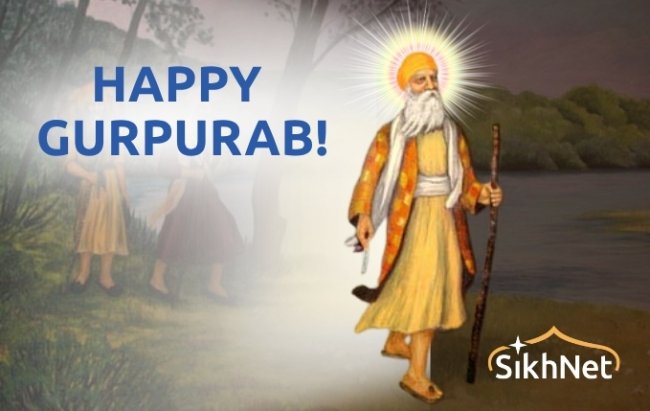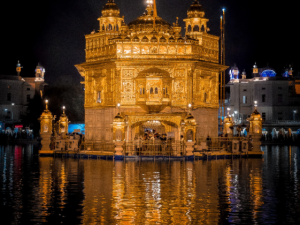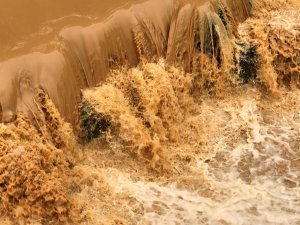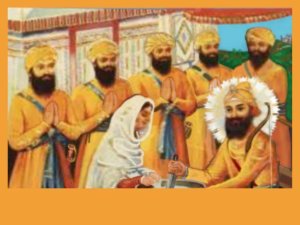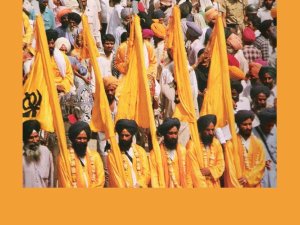Guru Amar Das Ji, the third Sikh Guru, played a pivotal role in shaping Sikhism. Born in 1479 in Basarke village (1) in present-day Pakistan, he became the third Sikh Guru in 1552 at the age of 73, succeeding Guru Angad Dev Ji.
His tenure marked a significant expansion of Sikhism. Guru Amar Das Ji established a hierarchical system of administration within the Sikh community, dividing the territory into 22 manjis (2) (ecclesiastical districts) to facilitate preaching and administration. He also institutionalized langar (community kitchen) as an integral part of Sikhism, promoting equality and service to humanity.
Guru Amar Das Ji's spiritual teachings emphasized the importance of devotion, humility, and service. He composed several hymns, which were later included in the Guru Granth Sahib, the holy scripture of Sikhism. His most famous composition is Anand Sahib, which reflects the bliss of union with the divine.
He was instrumental in promoting the role of women in Sikh society, abolishing discriminatory practices such as purdah (veiling of women) and sati (widow immolation). He also introduced the custom of Guru ka Langar, a free kitchen where all could eat regardless of caste, creed, or social status, fostering a sense of equality and community.
Guru Amar Das Ji’s legacy extends beyond his spiritual and social reforms. He laid the foundation for the concept of sangat (congregation) and pangat (egalitarian eating), which remain integral to Sikh religious practices. His contributions helped solidify Sikhism as a distinct faith and laid the groundwork for its future growth and influence. Guru Amar Das Ji passed away in 1574 (3), leaving behind a rich legacy of spiritual wisdom and social reform.
GOINDWAL SAHIB :
Goindwal Sahib, located on the banks of the River Beas, holds significant historical and religious importance in Sikhism. Founded in 1546 by Guru Amar Das Sahib (4), it became a prominent center of Sikh activity during his time.
Goindwal founded by Guru Amar Das Sahib in 1546, Goindwal Sahib gained prominence as a vital stop along the ancient east-west trade route crossing the River Beas.The town's significance further increased when Sher Shah Suri, the Afghan emperor, reconstructed the major road passing through it. Guru Amar Das Sahib shifted his residence from Khadur Sahib to Goindwal Sahib after ascending to the Guruship in 1552.In 1559, Guru Amar Das Sahib initiated the excavation of Bauli Sahib, a large well with 84 steps leading down to its water, which became a focal point for pilgrims.
Bauli Sahib: The well, adorned with marble steps and a decorated cupola, attracts pilgrims who come to bathe in its holy waters.
Thara Sahib Guru Amardas Sahib: A marble platform where Guru Amar Das Sahib supervised the excavation of Bauli Sahib.
Langar Guru Amardas Sahib: A large dining hall connected to the kitchen, providing meals to visitors.
Residence of Guru Amardas Sahib: A two-storied building offering accommodation to pilgrims.
Gurdwara Chubara Sahib: Also known as 'Haveli Sahib', it served as the residence of Guru Amar Das Sahib and his family, housing a room with a silver palanquin containing Sri Guru Granth Sahib.
Killi Sahib: A wooden key, now adorned with silver, where Guru Amar Das Sahib used to chant bhajans.
Jyoti Jyoti Asthan Patshahi Third: A marble site marking the place where Guru Amar Das Sahib passed away.
Chubara Baba Mohan Ji: Where Guru Amar Das Sahib's son, Baba Mohan Ji, lived and where Guru Arjan Sahib received the pothis for editing Guru Granth Sahib.
These Gurdwaras are managed under Section 85 of the Act by the Shiromani Gurdwara Parbandhak Committee of Goindwal Sahib. Hosts a three-day Jod-Mela annually on the Jyoti-Jyoti Purab of Guru Amar Das Sahib.
TARGA:
Targa village (5), situated six kilometers northeast of the tehsil town of Kasūr in Lahore district, holds historical significance within the Sikh tradition. Guru Amar Dās journeyed to this locale in response to an invitation extended by a Sikh Sangat from Kādīvind, an adjacent village. Upon arrival, he established his camp in the jungle approximately one kilometer west of Targā. The devout congregations from Kādīvind, Targā, and nearby villages flocked to witness the presence of the Gurū and partake in his spiritual teachings. Subsequently, a shrine named Gurdwārā Tīsrī Pātshāhī Jhārī (signifying "bush") Sahib was erected at this site. An annual religious fair commemorating Baisakhi was a customary observance, fostering communal unity and spiritual renewal. However, the fate of the Gurdwārā post-1947 remains shrouded in uncertainty, as documented accounts, such as "Sikh Shrines in West Pākistān" published by the Pakistan Government in 1962, do not make any reference to Targā.
KHADUR SAHIB :
Khadur Sahib holds significant historical and religious importance in Sikh tradition, particularly in relation to Guru Angad Dev and Guru Amar Das. It is situated approximately 20 kilometers east of Tarn Taran. The association with the Sikh Gurus traces back to Baba Pheru, the father of Bhai Lehna, who later became Guru Angad. The family settled in Khadur after their native village, Matte di Saran, was destroyed by Mughal invaders. Bhai Lehna, who had served Guru Nanak Dev at Kartarpur for twelve years, returned to Khadur permanently upon becoming Guru Angad Dev. Guru Amar Das, the third Sikh Guru, met Guru Angad Dev in Khadur and became his devoted Sikh.
Khadur Sahib is home to six historical Gurdwaras(6) but three are associated with Guru Amar Das ji.
Gurdwara Tapiāņā Sahib , located outside the village, is where Guru Nanak Dev stayed and addressed congregations. Bhai Jodha served him devotedly, and later, Guru Angad Dev also preached here. Local tradition suggests that the Bālā Janam Sakhi was compiled here.
Gurdwara Darbar Sahib Angīthā Sahib, now situated inside the village, marks the cremation site of Guru Angad Dev. Nearby stands a domed marble kiosk known as Killā Sahib or Khaddi Sahib, where Baba Amar Das once stumbled and had a spiritual realization. Adjacent to the Gurdwara is an old well named Bibi Amaro Ji dā Khūh, after Guru Angad's daughter.
Gurdwara Thara Sahib Gurū Amar Das is a domed room on a raised platform close to Darbar Sahib, where Baba Amar Das used to relax and meditate when free from serving the Guru.
BASARKE GILLAN : Basarke Gillan, commonly referred to as Basarke, is situated six kilometers southwest of Chheharta along the Chheharta-Dhand link road. This locale holds historical significance as the ancestral village of Guru Amar Das, who was born (7) here in the year 1479 . Bhai Jetha, later known as Guru Ram Das, spent his formative years under the care of his maternal grandmother in Basarke. Notably, Bibi Amaro, daughter of Guru Angad Dev, was married to a nephew of Guru Amar Das and resided in this village.Two prominent Gurdwaras grace the landscape of Basarke:
Gurdwara Janam Asthan: This sacred site represents the ancestral home of Guru Amar Das, situated on the site of the former village, which likely met its demise during the tumultuous events of the eighteenth century. Privately managed, this Gurdwara holds significant historical and cultural importance.
Gurdwara Sannh Sahib: The term "Sannh" refers to a hole made in a wall, often attributed to burglars. This Gurdwara commemorates a significant event in Sikh history when Guru Amar Das faced opposition from Datu, son of Guru Angad Dev, regarding his succession. In response to Datu's defiance, Guru Amar Das retreated to Basarke, where he secluded himself in a room, issuing a notice warning against forced entry under penalty of curse. Baba Buddha, upon learning of Guru Amar Das's whereabouts, ingeniously entered the room through a hole in the wall, thereby avoiding disobedience. This act of reverence and cleverness amused Guru Amar Das, leading to his return to Goindwal to lead the Sikh community.The room sanctified by Guru Amar Das's meditation and breached by Baba Buddha's stratagem became revered by Sikhs, leading to the establishment of Gurdwara Sannh Sahib. Sardar Lahina Singh Majithia laid the foundation for this Gurdwara, with subsequent development facilitated by Baba Kharak Singh during the 1950s. Affiliated with the Shiromani Gurdwara Parbandhak Committee (S.G.P.C.), this Gurdwara encompasses 150 acres of land and hosts various religious events, including the congregation fair commemorating the death anniversary of Guru Amar Das on the Puranmasi of the lunar month of Bhadon.
KHEM KARAN:
Khem Karan stands as an emblem of historical significance, nestled near the Indo-Pakistan border. Once serving as the terminus for the road and railway line connecting Amritsar with Kasür, its prominence has been underscored by the presence of two venerable shrines dedicated to the Sikh Gurus. Local lore recounts the establishment of a manji during the tenure of Gurū Amar Das, led by Bhai Khera, a Shaivite Brahmin who embraced Sikhism. It is believed that Gurū Amar Das himself may have traversed (8) through Khem Karan during his journeys to Targa and Kadiwind.
The Gurdwara Thamm Sahib (9), situated near the Kasür Gate, venerates the legacies of Gurū Amar Das and Gurū Hargobind. Central to its sanctity was a thamm, a wooden beam reputedly dating back to the Gurūs' era. Sadly, both the thamm and the original edifice succumbed to the ravages of the 1965 Indo-Pakistani conflict. However, a new structure emerged in 1966-67, housing the revered Gurū Granth Sahib. Notably, alongside other significant gurpurbs, the commemoration of Gurū Amar Das's death anniversary finds resonance within its walls.
DALLA:
Dalla village, situated six kilometers southeast of Sultanpur Lodhi, held significant importance within the Sikh community during the time of Guru Angad Dev and Guru Amar Das. This prominence was chiefly attributed to the leadership of two eminent Sikhs, Bhai Lālū and Bhai Pāro(10). Notably, Guru Amar Das himself graced Dalla with his presence, underscoring its spiritual significance. Furthermore, in the year 1604, Guru Arjan Dev honored Dalla with his visit during the auspicious occasion of his son, Guru Hargobind's wedding to Mātā Damodari, a scion of the esteemed lineage of Bhai Pāro.
Gurdwara Nathāņā Sahib, known also as Gurdwara Sahib Pātshāhī Teesarī, holds significant historical and religious importance, situated amidst the verdant fields approximately 1.5 kilometers distant from the locale of Jand Magholi (11), positioned equidistant between Jand Magholi and Pipal Magholi. Accessible more conveniently via Pipal Magholi, the shrine lies along the Ghanaur-Shambū thoroughfare, with Shambu serving as a pivotal point on the Grand Trunk Road between Ambālā and Rajpurā.
According to entrenched local lore, Gurū Amar Das, in the pursuit of his spiritual odyssey, graced this sacred site with his presence on no fewer than 22 occasions preceding his momentous encounter with Gurū Angad Dev, a pivotal event leading to his eventual embrace of Sikhism. Designated as a scheduled Gurdwārā under the auspices of the Shiromani Gurdwārā Parbandhak Committee (S.G.P.C.), it holds the esteemed Serial No. 247 within Schedule I, as delineated in the venerable Sikh Gurdwārās Act of 1925.
The architectural manifestation of Gurdwara Nathāņā Sahib manifests as a square hall, ensconced upon a broader, square, elevated dais, with the central nucleus housing the sanctum sanctorum, itself square in form. Surmounting this edifice, one finds a square chamber crowned by a pinnacle-bearing dome, emblematic of Sikh architectural tradition.
The congregational fervor at Sangrand occasions draws multitudes of devotees from the neighboring hamlets, testament to the enduring spiritual allure of this revered sanctuary. Furthermore, an annual religious convocation coincides with the festivity of Lohri, amplifying the significance of Gurdwara Nathāņā Sahib as a locus of spiritual communion and cultural celebration within the tapestry of Sikh religious observance.
KURUKSHETRA :
Kurukshetra, situated amidst the confluence of the Ghaggar and Saraswati rivers, delineates a region of profound religious significance, enveloping a township that encompasses various temple complexes, Kurukshetra University, and administrative headquarters, colloquially referred to as Kurukshetra. Adjacent to this contemporary settlement lies the ancient town of Thanesar. Renowned as a paramount sacred pilgrimage site for adherents of Hinduism, Kurukshetra has historically garnered attention during solar eclipses, attracting a vast congregation comprising Hindu devotees, ascetics, erudites, and laity who converge to partake in purifying ablutions within its expansive sacred reservoir.
Eminent Sikh Gurus, recognizing the sanctity of Kurukshetra, availed themselves of its auspicious occasions, notably during solar eclipses, to promulgate discourses denouncing superstitious observances prevalent among the populace. Among them, Guru Nanak Dev seized such a juncture in the early 16th century to expound teachings against ritualistic dogmas. Subsequently, Guru Amar Das (12), whose erstwhile visits to Kurukshetra as a Hindu pilgrim preceded his embrace of Sikhism, is documented to have journeyed to the site during his pontificate, potentially accompanied by Bhāī Jeṭhā, later recognized as Guru Ram Das, circa A.D. 1553. Further, Guru Hargobind's pilgrimage to Kurukshetra in 1638 during a solar eclipse, and possibly earlier during his transit to Nānak Matā in 1632-33, underscore the enduring significance of the locale within Sikh tradition. Successive Sikh Gurus, including Guru Har Rai, Guru Tegh Bahadur, and Guru Gobind Singh, similarly visited Kurukshetra, where sites commemorating their presence evolved into revered Gurdwaras.
Gurdwara Tisarī and Satvin Pātshāhī hold significant historical and spiritual resonance, as they commemorate the legacies of both Guru Amar Das and Guru Har Rai. Situated near Lal Bahadur Shastri Market, on the periphery of Thanesar, this sacred site stands as a testament to the profound teachings imparted by these revered Gurus. Guru Amar Das, in particular, expounded upon the futility of traditional pilgrimages and ablutions in holy waters as means of soul purification. Instead, he emphasized the singular efficacy of "nām" (the Holy Word) as the true pilgrimage, wherein immersion therein offers the ultimate spiritual cleansing. This philosophical stance underscores the primacy of inner spiritual communion over external rituals, encapsulating a profound insight into Sikh doctrine and spirituality.
HARIDWAR :
Haridwar, a renowned Hindu pilgrimage destination situated on the banks of the sacred Ganges River, has historically been frequented by numerous spiritual leaders across various traditions. Within this religious tapestry, the Sikh presence is notable primarily through the sole historic Sikh shrine, the Gurdwara located at Kankhal (13), in close proximity to the Sati Ghat, approximately three kilometers to the south of Haridwar proper. This revered site is dedicated to Guru Amar Das, a significant figure within Sikh tradition, and is meticulously overseen by the Nirmala Sikhs, reflecting the enduring interplay of faith and stewardship within the Sikh ethos.
References:
1. Narotam, Pandit Tara Singh(Ed) Dr, Mansa,P S —Sri Gur Tirath Sangrah, (1883),2022,Amritsar, P. 55
2.Teja Singh, Ganda Singh – A Short History of the Sikhs (Vol:1), 2006,Punjabi University Patiala, P:23
3. Narotam, Pandit Tara Singh, Sri Guru Tirath Sangrah, op. cit, p. 57
4. Sarna, Jasbir Singh, Bedi Daljit Singh – Gurdwara Kosh, Dharam Parchar Committee, SGPC, Amritsar, 2013,P:157
5. Gurmukh Singh, Major –Historical Sikh Shrines, (1995),2005, Singh Brothers, Amritsar, P:68
6. Sarna, Jasbir Singh et al, Gurdwara Kosh , Op. Cit, p:136
7.Harbans Singh – The Encyclopedia of Sikhism, Punjabi University Patiala, Vol 1 , p: 62
8.Sarna, Jasbir Singh et al , Gurdwara Kosh, op. cit, p:144-145
9.Gian Singh, Giani– Gurdham Sangrah, SGPC Amritsar, n. d, p:50
10.Gurmukh Singh, Maj– Historical Sikh Shrines, op. cit, p:133
11. Ibid, p:179 ,
12. Nabha, Kahn Singh – Gurshabad Ratnakar Mahankosh, Delhi , 1990,p: 624
13. Sarna, Jasbir Singh et al– Gurdwara Kosh, op. cit, p:106
